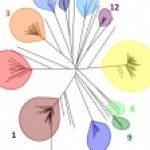Lien vers Pubmed [PMID] – 17416899
Eukaryotic Cell 2007 Jun;6(6):1041-52
We analyzed data on multilocus sequence typing (MLST), ABC typing, mating type-like locus (MAT) status, and antifungal susceptibility for a panel of 1,391 Candida albicans isolates. Almost all (96.7%) of the isolates could be assigned by MLST to one of 17 clades. eBURST analysis revealed 53 clonal clusters. Diploid sequence type 69 was the most common MLST strain type and the founder of the largest clonal cluster, and examples were found among isolates from all parts of the world. ABC types and geographical origins showed statistically significant variations among clades by univariate analysis of variance, but anatomical source and antifungal susceptibility data were not significantly associated. A separate analysis limited to European isolates, thereby minimizing geographical effects, showed significant differences in the proportions of isolates from blood, commensal carriage, and superficial infections among the five most populous clades. The proportion of isolates with low antifungal susceptibility was highest for MAT homozygous a/a types and then alpha/alpha types and was lowest for heterozygous a/alpha types. The tree of clades defined by MLST was not congruent with trees generated from the individual gene fragments sequenced, implying a separate evolutionary history for each fragment. Analysis of nucleic acid variation among loci and within loci supported recombination. Computational haplotype analysis showed a high frequency of recombination events, suggesting that isolates had mixed evolutionary histories resembling those of a sexually reproducing species.

